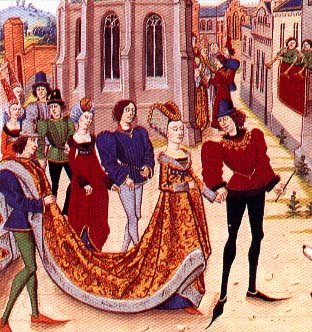

This handout is in support of the class, and covers shoes with points at the toe; mostly from the 15th century, but there is one picture of shoes from a tomb effigy of about 1314 which shows the basic early shoe with very mild points and metal mounts (decorations). The Museum of London's Shoes and Pattens book has an excellent chart showing found shoe shapes by region and time period, which I highly recommend to anyone interested in this topic.
The main sources for this informal reconstruction are below. Other points were added after conversations with Master Geoffrey Matthias, and I. Marc Carlson who have done a lot of research into this area. Anyone looking for more details on shoes would do well to consult with these gentlemen, or others, who have made more of a study of the subject than I have.
My goal is to get as many people into pointy shoes as possible;
they're not as difficult to walk in as it looks, and they are useful if
you are wearing the very long houppelande skirts! I hope that if
folks make these, they will be interested in making the real version,
out of heavy leather and sewn by hand in the accurate method.
This method is designed for either fairly thin leather (thin enough to
be sewn by a sewing machine) or, if you want to try on something less
expensive first, out of marine vinyl. Sturdy leather poulaines
are available from various sources, but the prices tend to be rather
high unless you're making a chunk of money. Hence, these are
"poor people's poulaines."
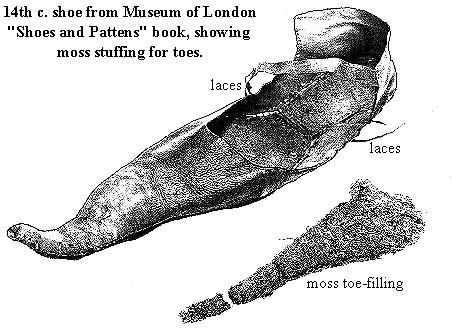
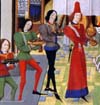
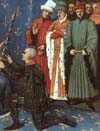
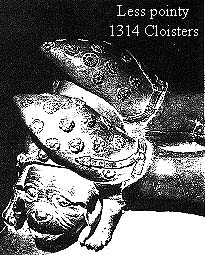 Shoes from a tomb
effigy in the Cloisters, 1314. Decorated with metal rounds, probably.
Other decorations were common; embroidery, leather cut-outs, leather
embossing or scoring, etc.
Shoes from a tomb
effigy in the Cloisters, 1314. Decorated with metal rounds, probably.
Other decorations were common; embroidery, leather cut-outs, leather
embossing or scoring, etc.
Note: Figure 12 of the page of many shoes from The Pictorial History of Costume is erroneous (toes held up by tying to the ankle with gilded chains.) It seems as if the evidence for toe-chains all originates later than the time that they "might" have been in use. Some say that an error in translation of a manuscript about 100 years ago introduced this imaginative bit of footwear. There are some descriptions from the 1500s that mention the toe-chains, but since they are not contemporary, they are suspect.
Marc Carlson (whose web pages on shoes I highly recommend to anyone) found the following citation, which supports his opinion that tying the points of the shoes to the knee was an incorrect assumption from later in history; in this case someone writing around 1550 or later, about a style prevalent 85-150 years earlier. The second paragraph cited is from this source:
Stow, John 1525?-1605 The survey of London containing the original, increase, modern estate and government of that city, methodically set down : with a memorial of those famouser acts of charity, which for publick and pious vses have been bestowed by many worshipfull citizens and benefactors : as also all the ancient and modern monuments erected in the churches, not only of those two famous cities, London and Westminster, but (now newly added) four miles compass (1598) - p.131.The citation reads:
"In Distar Lane, on the North side thereof, is the Cordwainers or Shoemaker's Hall, which company were made a brotherhood or fraternity in the 11th of Henry IV. Of these Cordwayners I read, that since the fifth of Richard II. (when he took to wife Anne, daughter to Veselaus, King of Boheme), by her example the English people had used piked shoes, tied to their knees with silken laces, or chains of silver or gilt, wherefore in the fourth of Edward IV. it was ordained and proclaimed, that beaks of shoone and boots, should not pass the length of two inches, upon pain of cursing by the clergy, and by Parliament to pay 20 shillings for every pair. And every cordwainer that shod any man or woman on the Sunday, to pay 30 shillings."
Certainly out of the hundreds of pictures I have seen that were created
in the middle ages, not one includes chains running from the long toe
of the shoe to either the knee or the ankle. (Just imagine how
easy it would be to trip and fall!) If you come across one, I'd
love to see it.
* So how long were these points, anyway? One fairly un-reliable source I have says that anyone who was lower than a prince could not wear points on their shoes that measured over six inches in length. If you look at the pictures in this handout you can see that the points during the 15th century seem to be between `half the foot long' and `as long as the foot' in most cases. You can do your own figuring for your own foot how long this really would be for you.
Materials needed:
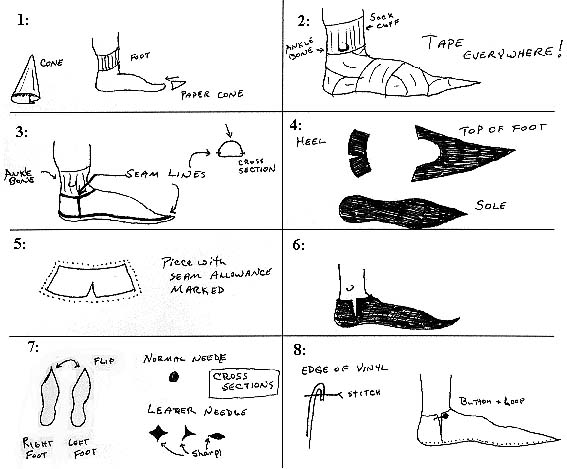
| All material © 1999 Cynthia Virtue | Email Author with comments |
| Back to Virtue Ventures Main Page | Back to Article Index |